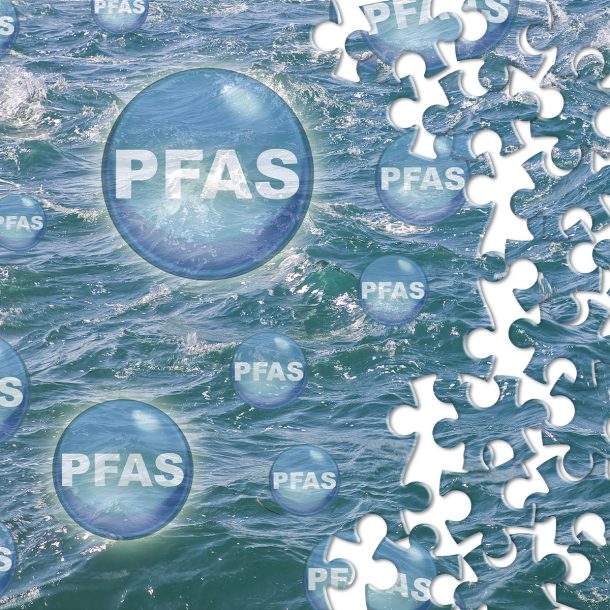-
Schaden & Unfall
Schaden & Unfall ÜberblickRückversicherungslösungenTrending Topic

Schaden & Unfall
Wir bieten eine umfassende Palette von Rückversicherungslösungen verbunden mit der Expertise eines kompetenten Underwritingteams.
-
Leben & Kranken
Leben & Kranken ÜberblickUnsere AngeboteUnderwritingTraining & Events

Leben & Kranken
Wir bieten eine umfassende Palette von Rückversicherungsprodukten und das Fachwissen unseres qualifizierten Rückversicherungsteams.
-
Unsere Expertise
Unsere Expertise ÜberblickUnsere Expertise

Knowledge Center
Unser globales Expertenteam teilt hier sein Wissen zu aktuellen Themen der Versicherungsbranche.
-
Über uns
Über uns ÜberblickCorporate InformationESG bei der Gen Re

Über uns
Die Gen Re unterstützt Versicherungsunternehmen mit maßgeschneiderten Rückversicherungslösungen in den Bereichen Leben & Kranken und Schaden & Unfall.
- Careers Careers
PFAS Awareness and Concern Continues to Grow. Will the Litigation it Generates Do Likewise?

22. Januar 2025
Tim Fletcher
Region: North America
English
In an event-filled 2024, public awareness turned to the impact that “forever” chemicals PFAS might have on public health, remediation costs, and ultimately those entities that could be charged with paying the economic toll, an issue we’ve been following since 2020. In part one of our two-part series, we provided a high-level overview as to how PFAS surfaced as a societal issue and the actions insurers might take in response. In this part, we recap PFAS litigation to date and cast a wary eye as to where it might lead in the future.
Affected Industries and Litigation to Date
While PFAS chemicals were largely phased out in the early 2000s, myriad other individual PFAS are still being used commercially today, with one study having identified more than 2,000 distinct uses for roughly 1,400 individual PFAS combinations spanning industries as ubiquitous as textiles, personal care products, food packaging, and firefighting (aqueous film forming foam or AFFF).1 Other, lesser-known applications (medical devices, laboratory equipment, and the molding and extrusion of plastic products) are also common.2
Given the vast array of PFAS uses, the footprint of involved industries and exposed companies is similarly expansive.3 These include the following:
|
Industry |
Description |
|---|---|
|
Primary Manufacturing |
Industries known to manufacture PFAS |
|
Secondary Manufacturing |
Industries known to incorporate PFAS into products or components |
|
Other Non-Manufacturing Industries |
Wholesalers, waste remediation and management, airports, energy refineries, real estates |
Source: Verisk Analytics, Inc, “PFAS: The Tip of the Tort Iceberg?,” July 18, 2024
Litigation activity has been increasingly brisk, with some 6,400 federal court lawsuits filed between July 2005 and March 2022, and thousands more filed since then.4 The bulk of PFAS litigation has fallen into the following general categories:5
- Firefighters versus the companies that manufactured, designed, and sold the fire suppressant AFFF with knowledge that it contained PFAS and carried adverse health consequences
- Public and private water utilities suing the entities that utilize PFAS (including AFFF), alleging that they contaminated water supplies that resulted in damages associated with drinking-water remediation and ongoing monitoring costs
- States’ attorneys general against PFAS manufacturers, distributors and suppliers for waterway contamination and violations of environmental statutes
- Individual plaintiffs suing PFAS manufacturers and sellers of products that contain PFAS, alleging illness and injury arising from drinking PFAS-contaminated water
- Actions against companies for violations of environmental statutes, predicated on their use and discharge of PFAS
- Consumer protection claims against companies asserting that their products contain PFAS, contrary to their marketing claims that the products carry health benefits
Concurrent with heightened litigation have come eye-popping settlements, particularly those relating to water remediation tied to the AFFF producers:6
|
Defendant |
Settlement Amount (in $ millions) |
Status / Date |
|---|---|---|
|
3M |
$10,500–$12,500 |
Final Approval in March 2024 |
|
Dupont |
$1,185 |
Final Approval in February 2024 |
|
Tyco |
$750 |
Preliminary Approval in July 2024 |
|
BASF |
$316 |
Preliminary Approval in July 2024 |
Source: Milliman, “PFAS liability estimate, pt. 1,” July 23, 2024.
Actuarial firm Milliman notes that because these settlements occurred before the EPA’s April 2024 designation of maximum contaminant levels (MCL) for PFAS and mandatory monitoring of those levels, subsequent litigation will grow as other non-settling districts discover the existence of PFAS in their systems and gain knowledge of the aforementioned settlements.7 Further, those costs in the aggregate could be astronomical, with one estimate suggesting total costs between $120 billion and $175 billon.8
While the pool of water remediation suits and settlements will likely expand going forward, the fate of consumer class actions appears murky. On one hand, these claims hold appeal to the mass tort plaintiffs bar, as they carry a greater likelihood of being certified as class actions than do personal injury claims.9 On another, these suits circumvent the significant hurdle present in personal injury suits – the need to show harm. This is particularly significant given the lack of reliable science as to the possible health impacts of PFAS, the levels of exposure required to have an impact, and, for that matter, the lack of consensus as to which chemicals are within the PFAS group, with the National Institute of Environmental Health claiming the number is 15,000 and the National Institute for Occupational Safety and Health pegging the number at around 9,000.10
Despite these seeming advantages, consumer class actions so far have foundered. For example, a federal district court in Washington dismissed a suit against outdoor outfitter REI because it failed to identify the specific PFAS compound in the REI-distributed jacket, as well as having not established reasonable reliance by the plaintiff as to allegedly deceptive representations.11 In California, another federal district court dismissed a consumer class action over the failure to plausibly demonstrate that tampons manufactured by the defendant contained PFAS.12 Finally, a federal district court in Illinois held that while plaintiffs did have standing due to alleged economic injury associated with PFAS in school uniforms, dismissal was appropriate in light of the defendant having made no representations that would lead a consumer to believe that the uniforms were completely PFAS‑free.13
Growing List of Health Concerns
Likely serving as a barrier to a potential tsunami of personal injury litigation is the lack of conclusive evidence that PFAS specifically causes harm, as do tobacco and asbestos with cancer.14 Moreover, no court to date has ruled that PFAS is responsible for illness.15
Regardless, numerous studies continue to link PFAS to adverse health consequences, such as recent findings that PFAS exposure might increase all-cause mortality, that the list of cancers associated with PFAS may be longer than previously known, and that new possible exposure pathways may exist, such as substantial PFAS absorption through the skin.16
Associations like these result from the keen scientific interest in how PFAS might be affecting our physical environments and our personal health, as shown by the explosive recent growth in articles investigating PFAS.
Number of Scientific Articles Investigating PFAS (by Year)

Increased scientific scrutiny has unearthed a number of disturbing findings, among them a growing sense among scientists that PFAS – along with other “everyday chemicals” such as Bisphenol A (BPA) – may be acting as “endocrine disrupters” that either imitate or block the hormones responsible for many of the body’s essential functions that include reproduction.17 One Mount Sinai study found that PFAS may disturb reproductive hormones, delay puberty, and increase risks for polycystic ovary syndrome and endometriosis.18 These findings come after other studies that correlate phthalates exposure to fertility issues in women and lower sperm counts in men.19
Trouble on the Farm?
In addition to mounting heath concerns looms another potential PFAS-related headache; namely, activities originally thought to be ameliorative and later found to be potentially harmful. In the 1970s, Congress passed the celebrated Clean Water Act, which required industrial plants to send wastewater not into rivers and streams, but instead to treatment plants that in turn produced sludge (also known as biosolids) to be used in agricultural fertilizer.20 Over the intervening decades, the practice – encouraged by the EPA – appeared to make environmental sense while also proving to be wildly popular; as of 2018 farmers had obtained permits to use the nutrient-rich sludge on roughly 70 million acres, or about one fifth of all agricultural land in the United States. Additional uses of the biosolids included landscaping, golf courses, and forest land.21
As might be expected, the sludge has been found to contain a slew of hazardous chemicals that include PFAS, with research showing that PFAS can enter the human food chain through tainted crops and livestock.22 Various state regulators have responded, such as Maine’s 2022 ban on sewage sludge and Michigan closing one farm after tests showed particularly high chemical concentrations in the soil and on grazing land.23 Sludge-driven lawsuits are on the rise; as an example, ranchers in Johnson County, Texas ceased sending their cattle to market and brought suit against two sludge producers, claiming the producers acknowledged the possibility of PFAS being present in their product, but nonetheless continued to provide it.24
What’s Next
History frequently unfolds in unforeseen and unexpected ways. So too will be the case with PFAS litigation. Multiple “known unknowns” will need to play out in the years ahead, including the extent to which the incoming administration emphasizes regulatory enforcement, future scientific discoveries that provide the yet-to-be established causative link between PFAS exposure and specific human affliction, and the continued and possibly strengthened public demands for clean drinking water and pathogen removal from the environment.
Whatever the pace and direction that litigation may take, this much is certain: “forever chemicals” will continue to cast a long shadow over humanity for decades to come, with impact to be felt at nearly all levels of societal and economic activity.
- Groth, Grulkowski, Anderson, Loughran, Tibbets, “The ‘forever chemical’ risk is now: An actuarial reserving study can help insurers prepare for PFAS claims and litigation,” Milliman, Nov. 6, 2023, https://www.milliman.com/en/insight/forever-chemical-risk-actuarial-reserving-insurers-prepare-for-pfas-claims-litigation
- Ibid.
- Verisk Analytics, Inc, “PFAS: The Tip of the Tort Iceberg?,” July 18, 2024, https://core.verisk.com/-/media/Emerging-Issues/EI-Files/FINAL_PFAS-Emerging-Issues-July-18-2024-Webinar.pdf
- Scott M. Seaman, Gar N. Lauerman, “A Primer on PFAS/Forever Chemical Claims: Regulation, Litigation, Large Losses & Insurance Coverage Issues,” Hinshaw & Culbertson [Mealey’s Pollution Liability Report], May 2024, https://www.hinshawlaw.com/assets/htmldocuments/News/Mealeys%20-%20A%20Primer%20On%20PFAS-Forever%20Chemical%20Claims%20-%20Regulation%20Litigation%20Large%20Losses%20d%20Insurance%20Coverage%20Issues.pdf
- Ibid.
- Groth, Grulkowski, “Milliman PFAS liability estimate, pt. 1: Water district remediation,” Milliman, July 23, 2024, https://www.milliman.com/en/insight/pfas-liability-estimate-water-district-remediation
- Ibid.
- Carrier Management, “PFAS Liability for Water District Remediation Costs Estimated Up to $175B,” July 30, 2024, https://www.carriermanagement.com/news/2024/07/30/264853.htm
- Malinowski, Feldon, Ovalle, “Consumer Class Actions May Be the Next Wave of PFAS Litigation,” ALM/Law.com, July 2, 2024, https://www.law.com/2024/07/02/consumer-class-actions-may-be-the-next-wave-of-pfas-litigation. Subscriber access only.
- Ibid.
- Krakauer v. Rec. Equip., Inc., No. C22‑5830 BHS, 2024 U.S. Dist. LEXIS 65346 (W.D. Wash. Mar. 29, 2024)
- Lowe v. Edgewell Pers. Care Co., 711 F. Supp. 3d 1097 (N.D. Cal. 2024)
- Garland v. Child.’s Place, Inc., No. 23 C 4899, 2024 U.S. Dist. LEXIS 59395 (N.D. Ill. Apr. 1, 2024)
- Margulies, Ben, “Re/insurers grapple with ‘hard-to-predict’ PFAS problem,” Insurance Day, Dec. 6, 2024, https://www.insuranceday.com/ID1151698/Reinsurers-grapple-with-hardtopredict-PFAS-problem#:~:text=For%20insurers%2C%20the%20PFAS%20threat%20combines%20scale%20and%20uncertainty&text=Some%20stem%20from%20dysfunctions%20in,which%20may%20produce%20unexpected%20liabilities
- Ibid.
- Scoblete, Greg, “The Health Concerns and Exposure Pathways for PFAS Are Growing,” Verisk, July 2, 2024, https://core.verisk.com/Insights/Emerging-Issues/Articles/2024/July/Week-1/Latest-PFAS-Health-Research
- Chaudhuri, Saabira, “As Fertility Rates Fall, Some Scientists Say Everyday Chemicals Are a Factor,” The Wall Street Journal, Dec. 14, 2024, https://www.wsj.com/health/fertility-chemicals-science-bc0964a1
- Ibid.
- Ibid.
- Tabuchi, Hiroko, “Something’s Poisoning America’s Land. Farmers Fear ‘Forever Chemicals’,” The New York Times, Aug. 31, 2024, https://www.nytimes.com/2024/08/31/climate/pfas-fertilizer-sludge-farm.html
- Ibid.
- Ibid.
- Ibid.
- Tabuchi, Hiroko, “Their Fertilizer Poisons Farmland. Now, They Want Protection From Lawsuits.” The New York Times, Dec. 6, 2024, https://www.nytimes.com/2024/12/06/climate/sludge-fertilizer-synagro-lobbying.html

